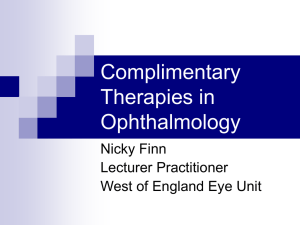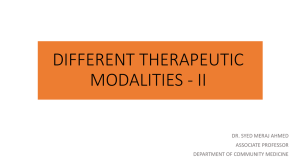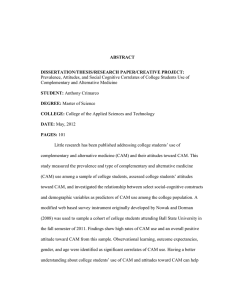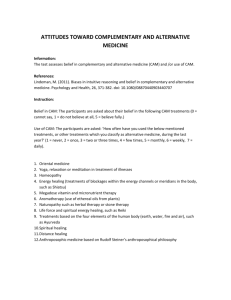Students' Perception, Familiarity, and Knowledge in the ... Herbal Supplements in Health Promotion
advertisement
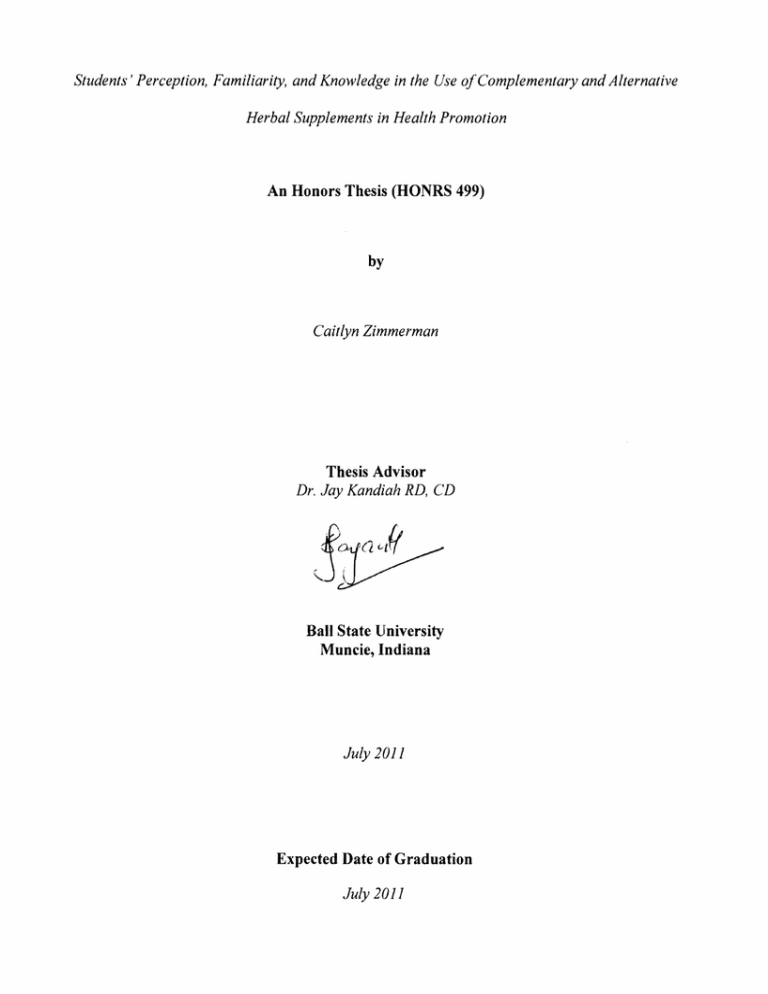
Students' Perception, Familiarity, and Knowledge in the Use o/Complementary and Alternative Herbal Supplements in Health Promotion An Honors Thesis (HONRS 499) by Caitlyn Zimmerman Thesis Advisor Dr. Jay Kandiah RD, CD Ball State University Muncie, Indiana July 2011 Expected Date of Graduation July 2011 -- I LIn t 1 ABSTRACT This study sought to e~~fufAe perception, familiarity, and knowledge related to college students' use of herbal supplements in health promotion. Students at a Mid-Western university were invited to participate in a 12-itemized Perception, Familiarity, and Knowledge Survey (PFKS). The PFKS online survey included questions regarding demographics, perceptions of complementary and alternative medicine, familiarity, and knowledge of gingko, ginseng, St. John's Wort, garlic, echinacea, and cinnamon. Two-hundred and eighty-six college students successfully completed the study. Chi-Square analysis, showed that 80.8% of students were familiar with complementary and alternative medicine (CAM) (p = .000). Majority were familiar with ginkgo (82.40/0), ginseng (96.1 %), St. John's Wort (78.4%), garlic (98.4%), echinacea (65.6%), and cinnamon (96.80/0). Despite familiarity of these herbs, 45.1 % - 74.1 % of the participants were unsure of the herb's effectiveness in preventing diseases or promoting good health. Only 43.3% had no prior knowledge of the six herbs. Students perceived barriers to CAM awareness were insufficient education (26.0%), lack of scientific evidence (25.9%), and lack of trained professionals (17.5%). Many students (85.8%) desired educational courses on CAM therapies, with nutrition professors being ranked highest by 88.0%. Over 60.0% of the students thought conventional medicine could benefit from CAM and that it should be integrated into healthcare practices. In conclusion, college-students appear to be highly interested in increasing their knowledge on CAM and herbal supplements, but currently have little experience and familiarity with herbal supplements. Key words: Complementary and alternative medicine, herbal supplements, college students, perception, familiarity, knowledge 2 ACKNOWLEDGEMENTS I would like to thank Dr. Jay Kandiah for her graciousness and thoroughness in advising me through this long and difficult process. It was her skills and abilities that made this an excellent experience. Her encouragement gave me the motivation to finish well. I want to thank Dr. Jim Jones, a statistician at the university, for his time and energy in assisting me with this task. I an1 very appreciative of his contribution and would not have been successful without his help. Lastly, I thank my parents and sister for their support, encouragement, and prayers. 3 INTRODUCTION In 2007, the Department of Health and Human Services (DHHS) recorded trends of complementary and alternative medicine (CAM) within the United States among adults, children, and various ethnic groups in the National Health Statistics Report of2007. It was found that 38.3% ofaduIts living in the United States used some form of CAM, and 17.70/0 used herbal supplements. Herbal supplements, also known as, "nonvitamin, nonmineral, natural products," is defined as, "products ... taken by mouth and contain a dietary ingredient intended to supplement the diet other than vitamins and minerals. Examples include herbs, herbal medicine, [and] other botanical products" (1). In 2006, Americans spent approximately $15 billion on herbal supplements (1). According to the DHHS, the five most prevalent supplements used by adults in the United States were fish oil/omega-3, glucosamine, echinacea, flaxseed oil or pills, and ginseng at 37.4%, 19.9%, 19.8%, 15.9%, and 14.1 %, respectively (1). Herbal supplenlents were used most commonly for the treatment of diseases and sicknesses such as back (17.1 %), neck (5.9%), joint (5.2%), pain (3.5%), and arthritis. Seventy percent of users ranged between 40-69 years. Females were higher users with 21.9% using a "biological based therapy" supplements inclusive of herbal compared to 17.8% males (1). Eisenberg et aI., compared trends of CAM from 1990 to 1997 and noted that those with college education were more likely (50.6%) to choose some form of alternative medicine, with herbal supplements being the largest (2). Most research completed on the perception, familiarity, and knowledge of herbal supplements thus far have focused on mainly adults, children, or college students living overseas (1 - 14). However, there has been very limited research on the use of herbal supplements by college students residing in the United States. Review of literature on United States college-aged populations found that from a pool of 59 students who completed required or experimental 4 courses on herbal supplements, 50.0% had a higher perception and felt adequately knowledgeable on the subject (15). Harris et al. assessed 63 pharmacy students' perceptions, familiarity, and knowledge on herbal supplements and found that 73.0% were desirous to increase their knowledge (16). According to the National Center for Complementary and Alternative Medicine (NCCAM), use of herbal supplements is increasing and will continue to rise in the years to come (13). With parents administering medicinal herbs to children as a preventative alternative to traditional drugs (10, 11), it will be interesting to assess the use of these products during the transitional stage into college life. Therefore, the purpose of this study is to research college students' perception, familiarity, and knowledge of herbal supplements in health promotion. METHODS Participants College students enrolled during the first summer session at a Mid-Western university were invited to participate in an online survey. The inclusion criteria included being i) 2:: 18 years of age; ii) prior knowledge of herbal supplements; and iii) familiarity of CAM. The recruitment email informed participants of the following parameters related to the study: criteria for participation, purpose of research procedures, and time commitn1ent related to the research. Subjects were informed by completing and submitting the survey, they were giving their consent. Duration for completion of the survey was two weeks. Prior to the start of the research, the University's Institutional Review Board approved all aspects of this project. Instrumentation The 12-itemized Perception, Familiarity, and Knowledge Survey (PFKS), developed by the researchers, was accepted for face validity by five registered dietitians (Appendix). Reliability was established by surveying a small sample (n=30) of students other than the study population 5 who were of similar characteristics. Subjects took the survey twice, with 1.5 weeks between each administration. Test-retest results were conducted from the same participants to assess similarity of answers to each test. The Kappa coefficient from the test-retest ranged from a low of .12 1.00, with a median coefficient of .47. The PFKS included questions on demographics, perception, familiarity, and knowledge of herbal supplements. Demographics included: i) year in school; ii) gender; iii) major; and iv) ethnicity. Students' perception, familiarity, and knowledge of gingko, ginseng, St. John's Wort, garlic, echinacea, and cinnanl0n were assessed. A three point Likert-type scale was used to evluate students' familiarity of the herbs. Students indicated if they had "Heard about the herb," Heard and have used the herb," or "Never heard about the herb." Students assessed their perceptions on the effectiveness of these herbs in preventing diseases and promoting good health, by use of the Likert-type scale. Ratings were classified as "Effective," Not effective," or "Unsure of effectiveness." Students' knowledge was evaluated by directing participants to match the use of the herbs in the treatment or prevention of various diseases and sicknesses. Perceived barriers to CAM awareness by students were assessed. The PFKS questioned whether CAM education should be provided at the university setting, and who participants thought would be qualified to teach the course. Finally, students were questioned on their perception of whether CAM could benefit conventional medicine, if CAM and conventional medicine should be integrated into healthcare practices, and whether the use of CAM modalities not supported by scientific evidence should be used in healthcare practices. Ratings were recorded on a Likert-type scale ranging from "Strongly agree" to "Strongly disagree." 6 Statistical Analysis The Chi-Square test of association was used to examine class rank (frequency) of students and gender in relation to perception, familiarity, and knowledge of herbal supplements. Significance was established at p S .05. RESULTS Two-hundred and eighty-six college students (86 males, 23.8%; 276 females, 76.2%) successfully completed the online survey. Class rank of participants included 20.8% freshmen/sophomores, 36.1 % juniors/seniors, and 43.0% graduates. Most subjects were Caucasian (n:::: 323; 88.7 010), and few were either African American (n 4; 1.1%), Asian (n:::: 15; 4.1%), or other (n 8; 2.2%), Hispanic (n:::: 14; 3.8%) ethnicities such as Middle Eastern, biracial, Irish, and Polynesian. There was an association between class rank and students' familiarity of ginkgo (l :::: 26.77, df= 4, p S .001). Most graduate students (77.9%) were familiar with the herb compared to 46.0% of freshmen/sophomores and 65.1 % of juniors/seniors. Unfortunately, there was no association between subjects' perception and knowledge of gingko in relation to class rank or gender (Table 1). Chi-Square test revealed an association between class rank and the students' familiarity of ginseng (l = 9.89, df= 4, P = .042). Interestingly, more juniors/seniors (37.0%) claimed to use ginseng while graduates (29.0%) and freshmen/sophomores (26.5%), were less likely to use it. Unexpectedly though, 57.5% of juniors/seniors had heard about the herb, compared to 70.2% graduates. Similarly, association was demonstrated by Chi-Square test in relation to students' familiarity of ginseng and gender (X 2 12.89, df= 2, p = .002). More males (49.3%) consumed ginseng, compared to 26.6% of females, while 69.1% of females and 47.90/0 of males had only 7 heard about the herb. Students' perception and knowledge of ginseng provided no significant data. Associations were expressed between students' familiarity of St. John's Wort and class rank (X2 = 19.48, df 4, p .001). More participants indicated their familiarity ofSt. John's Wort than expected, with responses consisting of 50.0% freshmen/sophomores, 57.9% juniors/seniors, and 74.4% graduates. Assessment of subjects' perception and knowledge on St. John's Wort were statistically insignificant. The Chi-Square test revealed an association between class rank and gender with responses related to students' familiarity of garlic (Table 2). Fifty percent of freshmen/sophomores, 52.0% of juniors/seniors, and 42.0% of graduates had used the herb (l = 11.03, df= 4, P = .026). When comparing gender, 59.2% of males and 43.6% of females had used garlic (X2 = 6.69, df= 2, p = .035). Additionally, there was an association between gender and responses related to perception of garlic as a preventative medicine (l = 6.88, df 2, p .032). Notably, 38.60/0 of males and 27.4% of females perceived garlic as effective. However, 47.1 % of males and 64.3% of females were unsure of garlic's effectiveness as a preventative medicine. Data concerning perception and knowledge of garlic was statistically insignificant. An association was observed between class rank and students' familiarity of echinacea, as revealed by the Chi-Square test (x2 24.90, df= 4, P ~ .001). As expected, freshmenlsophomores were least familiar, with 56.00/0 indicating unfamiliarity with the herb. Juniors/seniors were second highest with 38.9% followed by graduates at 21.5%. More than onethird (31.5%) of graduates had taken the herb, compared to 19.0% of juniors/seniors and 8.0% of freshmen/sophomores. The Chi-Square test revealed associations between class rank and students' knowledge of echinacea. Results indicated that 70.0% of graduates, 50.0% of juniors/seniors, and 20.0% offreshmenlsophomores identified its use in disease prevention (X2 8 20.74, df== 10, p .023). This was surprising because many of the students from all class ranks indicated a low familiarity of echinacea. Perhaps the high correct response rate from graduates' was due to the popularity of echinacea in the 1990's (17), a time when current freshmen/sophomores may have been too young to understand or care about its potential effectiveness. No other data concerning perception of echinacea was significant. As noted in Table 3, an association existed between class rank and perception of barriers to CAM awareness. These barriers included lack of media exposure (X2 == 9.84, df== 2, p == .007), insufficient education (X2 8.60, df == 2, p == .014), and limited availability in stores (i == 6.40, df == 2, p == .041). Less than 25.0% (23.3%) of graduates stated they did not receive lack of media exposure as a significant barrier. However, freshmen/sophomores and juniors/seniors saw this as slightly more ofa barrier (45.7% and 37.0%, respectively). Surprisingly, results indicated that 72.4% of juniors/seniors perceived inadequate education as a barrier to CAM. Interestingly, freshmen/sophomores and graduate students were fairly close in their perception (54.3% and 56.6%, respectively) of education as a barrier to CAM awareness. Limited availability of herbs in stores was significantly low as a potential barrier to CAM awareness. This view was shared by all class ranks with 87.0% of freshmen/sophomores, 82.7% of juniors/seniors, and 93.0% of graduate students in agreement. All other barriers to CAM awareness were statistically insignificant. DISCUSSION Several studies have investigated either perception, familiarity, or knowledge of CAM or herbal supplements among various groups of people. To date, little research has been conducted on all these factors as they relate to college students residing in the United States. Results from this study in relation to perceptions of CAM were consistent with previous research. In 2005, Yeo et al. surveyed medical students where 92.0% believed that conventional 9 medicine would be more beneficial than CAM (3). In the present study, 82.5% agree with this statement, indicating their caution in the acceptance of all CAM therapies. In 2006, Harris et al. found that 53.00/0 of students discouraged use of CAM therapies if it was not supported by scientific evidence (16). However, this research showed that only 33.9% of students agreed that CAM use should be discouraged if there was a lack of scientific support. After 5 years, the proportion of students who demanded scientific evidence had decreased by 19.1 %. A possible explanation for this could be due to more media exposure, more influence on children by parents who use CAM, more CAM education, or seeking answers outside of conventional medicine. Students' interests in understanding and increasing their knowledge on CAM therapies were sin1ilar to former research (3, 16). When compared to previous investigators, there was a 5.8% increase in the number of students who believed that education on CAM should be incorporated into academia (85.8% vs. 80.0%) (16). Results regarding students' knowledge of herbal supplements were similar to other research. In 2008, Xu found that respondents expressed great interest in herbal supplements but lacked knowledge on its uses (4). As earlier evidence have exhibited, subjects conveyed a high interest in learning and having more resources about herbal supplements, where as in the present study, students simply commented on their desire for CAM educational courses. A variety of majors (85.8%) stated that they wanted CAM courses. Congruency existed between past and present research related to participants' interest in CAM education, especially the efficacy of herbal supplements. However, research supports that most subjects had limited experience with herbal supplements with more than 50.0% (n = 277) of responses answering "unsure of effectiveness" (3). However, in contrast, Harris et al. recorded that a majority (65.0%; n = 41) of students viewed herbal supplements as moderately effective, revealing greater knowledge base and experience with herbal supplements (16). 10 Strengths of the study included ease of accessibility to the survey by participants' assessment of three parameters namely perceptions, familiarity, and knowledge of college students and evaluation of six commonly used herbs by college students. Some of the limitations were a low participant response rate and a lack of ethnic diversity. Future recomn1endations for research related to herbal supplements include: i) investigating the success of incorporating a CAM course into university curriculum as either a required or elective course; ii) clinical research on efficacy of specific herbal supplements in college population; and/or iii) effects of media on perceptions of CAM among college students. CONCLUSION In conclusion, college students had low levels of knowledge and experience with CAM yet maintained a high interest in receiving education on CAM. Additionally, they would like to see the use of CAM and conventional medicine in the healthcare setting. 11 Table 1: Students' familiarity on six herbs by gender. Gender ! Female Male Never heard of it Heard about it Heard about it and used it Never heard of it Heard about it Heard about it and used it 16.9% 64.40/0 18.3% 18.00/0 68.2% 13.7% Ginseng 2.80/0* 47.9%* 49.30/0* 4.3%* 69.10/0* 26.6%* St. John's Wort 25.40/0 56.3% 18.3% 20.70/0 65.9% 13.4% Garlic 2.80/0** 38.0%** 59.20/0** 1.30/0** 55.1%** 43.6%** Echinacea 42.3% 39.4% 18.30/0 32.3% 44.00/0 23.70/0 Cinnamon *p < .01 **p < .05 5.6% 38.00/0 56.3% 2.60/0 49.60/0 Herbs: Ginkgo i I 47.90/0 Table 2: Students' familiarity on six herbs by class rank. Class rank Juniors/Seniors Fresh men/Sophomores Graduates . , Herbs: Ginkgo I Never heard about it Heard about it Never heard of it Never heard about it Heard about it 38.0%* 46.0%* 16.0%* 20.6%* 65.1%* Heard about it and used it 14.30/0* Never heard about it Heard about it 6.90/0* 77.90/0* Heard about it and .used it 15.30/0* Ginseng St. John's Wort Garlic 8.2%** 65.30/0** 26.50/0** 5.5%** 57.5%** 37.0%** 0.8%** 70.20/0** 29.0%** 36.0%*** 50.0%*** 14.0%*** 27.80/0*** 57.9%*** 14.3%*** 10.1 %*** 74.40/0*** 15.50/0*** 0.0%** 50.0%** 50.0%** 3.9%** 44.10/0** 52.00/0** 0.00/0** 58.0%** Echinacea 56.0%* 36.00/0* 8.00/0* 38.90/0* 42.1%* 19.00/0* 21.50/0* 46.9%* I 42.00/0** 31.50/0* i Cinnamon *p<.OOl **p < .05 ***p <: .01 2.0% 42.00/0 56.0% 5.50/0 43.30/0 51.2% 1.50/0 51.90/0 46.6% ! 12 Table 3: Class rank and students' perception of barriers to CAM awareness. Class Rank Freshmen/ Sophomores Juniors/Seniors Graduates 50.0% 60.6% 69.0% 43.5% 44.1% 40.30/0 45.70/0* 37.00/0* 23.3%* Insufficient education Lack of availability of herbs in stores 54.3%** 72.40/0** 56.60/0** 13.0%** 17.3%** 7.0%** Expense of herbs Other *p < .01 **p < .05 28.3% 8.7%** 20.50/0 3.90/0** 18.6% 13.2%** Barriers: Insufficient scientific evidence Lack of trained professionals Lack of media/advertisements 13 References 1. Barnes PM, Bloom B, Nahin RL. Complementary and alternative medicine use among adults and children: United States, 2007. National Health Statistics Report. Retrieved from http://www.cdc.gov/nchs/datalnhsr/nhsr012.pdf. 2008. Accessed March 23,2011. 2. Eisenberg DM, Davis RB, Ettner SL, Appel S, Wilkey S, Van Rompay M, Kessler RC. Trends in alternative medicine use in the United States, 1990-1997: Results of a followup national survey. Journal of American Medical Association. 1998; 280.18:1569-75. Accessed April 11, 2011. 3. Yeo ASH, Yeo JCH, Yeo C, Lee CH, Lim LF, Lee TL. Perceptions of complementary and alternative medicine amongst medical students in singapore - a survey. Acupuncture Medicine. 2005; 23: 19-26. Accessed January 29,2011. 4. Xu S, Levine M. Medical Residents' and students' attitudes towards herbal medicines: A pilot study. Can J Clin Pharmacol. 2008; 15.1. Accessed June 20,2011. 5. Astin JA. Why patients use alternative medicine: Results of a national study. Journal of American Medical Association. 1998; 279.19: 1548-1553. Accessed March 29,2011. 6. Ernst E. The role of complementary and alternative medicine. BMf. 2000; 321: 1133-5. Accessed June 17,2011. 7. Grey M. Educating Professionals on complementary and alternative options for care as part of a total wellness protocol. http://alternativeducators.com!Articles/Benefitsof utilizationofcomplimentarymodalities.pdf. 2009. Accessed February 6,2011. 8. Krasuski RA, Michaelis K, Eckart RE. The cardiovascular patient's perceptions of complementary and alternative medicine. Clin. Cardiol. 2006; 29:161-164. Accessed March 27, 2011. 14 9. Klepser TB, Doucette WR, Horton MR, Buys LM, Ernst ME, Ford JK, Hoehns JD, Kautzman HA, Logenlann CD, Swegle JM, Ritho M, Klepser ME. Assessment of patients' perceptions and beliefs regarding herbal therapies. Pharmochoterapy. 2000; 20: 1. Accessed March 29, 2011. 10. National Institute of Health. Complenlentary and Alternative Medicine Use and Children. National Center for Complementary and Alternative Medicine, http://nccam.nih.gov/healthlchildren. Accessed March 22, 2011. 11. Barnes PM, Bloom B, Nahin R. CDC National Health Statistics Report #12. Complementary and Alternative Medicine Use Among Adults and Children: United States. 2007. Accessed June 5, 2011. 12. Taylor D, Walsham N, Taylor SE, Wong LF. Conlplementary and alternative medicines versus prescription drugs: perceptions of emergency department patients. Emerg Med J. 2006; 23. Accessed March 29,2011. 13. Barnes PM, McFann, K, Nahin RL. Complementary and Altenlative Medicine use among adults: United States, 2002. National Center for Complementary and Alternative Medicine: Advanced data. 2004; 343. Accessed July 1, 2011. 14. Evans E, Evans J. Changes in pharmacy students' attitudes and perceptions toward complementary and alternative medicine after completion of a required course. American Journal of Pharmaceutical Education. 2006; 70:5. Accessed March 29,2011. 15. Hopper I, Cohen M. Complementary therapies and the medical profession: A study of medical students' attitudes. Altern Ther Health Med. 2001; 4.3:68-73. Accessed June 20, 2011. 15 16. Harris 1M, Kingston RL, Rodriquez R, Choudary V. Attitudes towards complementary and alternative medicine among pharmacy faculty and students. American Journal of Pharmaceutical Education. 2006; 70.6. Accessed June 20, 2011. 17. McMillen BK, Mulvihill C. About echinacea. University of Pittsburg at Bradford. 1998; http://www.pitt.edu/-cjm6/w98echin.html. Accessed July 7, 2011. Appendix: Perception, Familiarity, and Knowledge Survey Please answer these questions to the best of your ability. 1. Major? (Write in) 2. Gender? a. Male b. Female 3. Year in a. b. c. d. e. f. school? Freshmen Sophomore Junior Senior Fifth year or higher in undergraduate degree Graduate (i.e. MS, MA, PhD, etc.) 4. Race? a. b. c. d. e. f. g. Caucasian African American Hispanic Native American Asian Other, please specifY. Prefer not to answer. Please complete the following questions entitled, "Students' Health Perceptions of Complementary and Alternative Medicinal Herbs." For the purposes of this study, complementary and alternative medicine is defined as "Approaches to healing not usually found in a doctor's undergraduate training nor offered in public hospitals. Included are traditional medicines, practices and beliefs borrowed from other cultures, the so-called natural therapies, the plant-based medicines of homeopathy and herbalism, and manipulative techniques of chiropractic, osteopathy, and massage. It does not include physiotherapy, occupational therapy, or self-medication with nonprescribed treatments such as vitamins" 5. Have you heard of the term, "Complementary and Alternative Medicine? a. Yes b. No I. If no, thank you! Please hit the submit button to exit the survey. 11. If yes, please proceed to the next question. 6. Please mark the appropriate box on your familiarity with each herb. , Herb: Heard about the herb Heard and have used the I herb Ginkgo Ginseng St. John's Wort I i Garlic Echinacea Cinnamon N ever heard about the herb 11 7. Do you think that each herb is effective in the promotion of good health? Not effective Effective Herb: Ginkgo Ginseng St. John's Wort Garlic Echinacea Cinnamon 8. Do you think that each herb is effective in the prevention of disease states? Not Effective Effective Herb: Ginkgo Ginseng St. John's Wort Garlic Echinacea Cinnamon Unsure of effectiveness Unsure of Effectiveness ' 9. Please select one or more appropriate herbs that you believe heals or overcomes each disease/sickness state. St. Cinnamon Garlic Ginseng Cloves Basil Echinacea Herb: Ginkgo Peppermint John's Wort Commonly used to lower blood lipid levels. Commonly used to increase physical endurance and reduce fatigue. Common ly used for flu and cold symptoms. Commonly used in patients with memory loss. Commonly used in treatment of diarrhea and • abdominal pain. i Commonly used for treatment of mild to moderate depr~ssion. HI 10. Of the barriers listed below, which do you think is the strongest barrier to increasing use and awareness of complementary and alternative medicine (CAM)? Check all that apply. a. Insufficient scientific evidence b. Lack of trained professionals c. Lack of media/advertisements d. Insufficient education e. Lack of availability of herbs in stores f. Herbs are expensive g. Other, please specify. _ _ _ _ _ __ 11. Do you think there needs to be more education on CAM in university settings? a. Yes b. No i. If yes, answer question 12. 11. If no, continue to question 13. 12. Which professors do you think should be in charge of teaching information relating to CAM? Check all that apply. a. b. c. d. e. f. Nutrition Nursing Biology Health Science Physical Education Other, please specify. 13. Please ind icate your ratings of these statements. There are five ratings ranging from "Strongly Disagree" to "Strongly Agree." Rating Scale: Strongly Disagree Neutral Agree Strongly Disagree Agree Conventional medicine can benefit from CAM. Conventional medicine and CAM should be integrated into healthcare practices. CAM methods that have not been scientifically tested should be discouraged from conventional medical use. Welcome to IRBNet Caitlyn Zimmerman Review Details [208932-2] Students' Health Perceptions of Complementary and Alternative Medicinal Herbs Ball State University IRB, Muncie, IN Submission Details Project Administration Project Overview Designer Share this Project Sign this Package Submit this Package Delete this Package Send Project Mail Other Tools Forms and Templates Submitted To Ball State University IRB, Muncie, IN Submitted by Caitlyn Zimmerman Submission Date 05/20/2011 Submission Type Amendment/Modification Local Board Reference Number Review Details: Agenda Review Type Status Effective Date 06/01/2011 10:00 AM Exempt Review Approved OS/20/2011 Expiration Date Board Documents: Document Type Description Exempt Letter Exempt Letter Last Modified OS/20/2011 01: 34 PM Copyright © 2002-2011 Research Dataware. All Rights Reserved. View CITI Collaborative Institutional Training Initiative Social & Behavioral Research - Basic/Refresher Curriculum Completion Report Printed on 7/16/2011 Learner: Caitlyn Zimmerman (username: cazimmerman2) Institution: Ball State University Contact Information 1704 N. Glenwood Ave. Muncie, IN 47304 United States Department: Family and Consumer Science Phone: 765-546-9034 Email: cazimmerman1@gmail.com Social & Behavioral Research - Basic/Refresher: Choose this group to satisfy CITI training requirements for Investigators and staff involved primarily in Social/Behavioral Research with human subjects. Stage 1. Basic Course Passed on 12/30/10 (Ref # 5393308) Date Completed Score I 12/30/10 13/3 (100%) 1 12/30/10 18/10 (80%) 1 12/30/10 4/4 (100%) I 12/30/10 5/5 (100%) 12/30/10 5/5 (100%) Required Modules Belmont Report and CITI Course Introduction Students in Research - SBR History and Ethical Principles - SBR Defining Research with Human Subjects - SBR The Regulations and The Social and Behavioral Sciences - SBR I Assessing Risk in Social and Behavioral Sciences - SBR I Informed Consent - SBR 1 Privacy and Confidentiality - SBR I Research with Prisoners - SBR I Research with Ch ild ren - S BR Research in Public Elementary and Secondary Schools SBR International Research - SBR Internet Research - SBR Research and HIPAA Privacy Protections Workers as Research Subjects-A Vulnerable Population Conflicts of Interest in Research Involving Human Subjects Ball State University 1 I 15/5 (100 %) 4/5 (80%) 12/30/10 12/30/10 12/30/10 12/30/10 12/30/10 12/30/10 5/5 (1000/0) 14/4 (100%) 13/4 (75%) 4/4 (100%) 12/30/10 12/30/10 12/30/10 12/30/10 12/30/10 13/3 (1000/0) 14/4 (1000/0) 17/11 (64 %) 4/4 (100%) 0/2 (0%) 12/30/10 I no quiz For this Completion Report to be valid, the learner listed above must be affiliated with a CITI participating institution. Falsified information and
